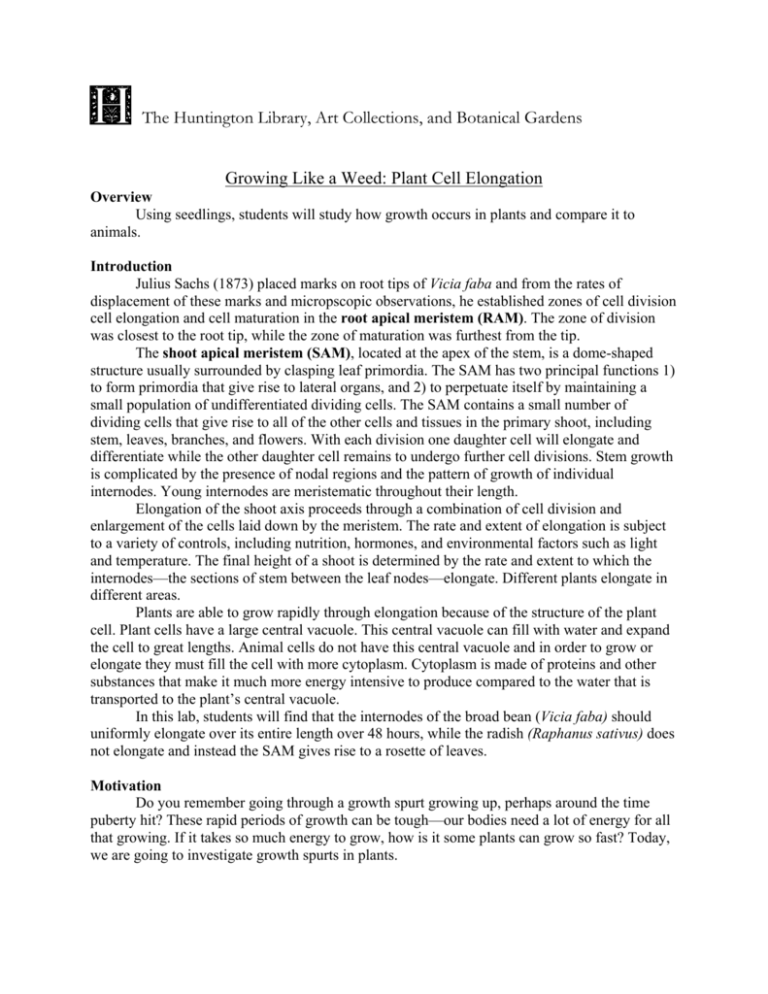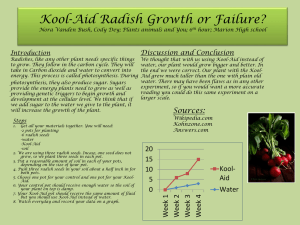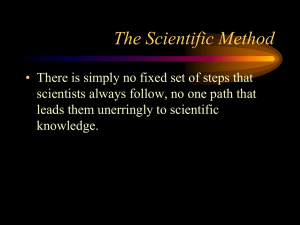Growing Like a Weed: Plant Cell Elongation
advertisement

The Huntington Library, Art Collections, and Botanical Gardens Growing Like a Weed: Plant Cell Elongation Overview Using seedlings, students will study how growth occurs in plants and compare it to animals. Introduction Julius Sachs (1873) placed marks on root tips of Vicia faba and from the rates of displacement of these marks and micropscopic observations, he established zones of cell division cell elongation and cell maturation in the root apical meristem (RAM). The zone of division was closest to the root tip, while the zone of maturation was furthest from the tip. The shoot apical meristem (SAM), located at the apex of the stem, is a dome-shaped structure usually surrounded by clasping leaf primordia. The SAM has two principal functions 1) to form primordia that give rise to lateral organs, and 2) to perpetuate itself by maintaining a small population of undifferentiated dividing cells. The SAM contains a small number of dividing cells that give rise to all of the other cells and tissues in the primary shoot, including stem, leaves, branches, and flowers. With each division one daughter cell will elongate and differentiate while the other daughter cell remains to undergo further cell divisions. Stem growth is complicated by the presence of nodal regions and the pattern of growth of individual internodes. Young internodes are meristematic throughout their length. Elongation of the shoot axis proceeds through a combination of cell division and enlargement of the cells laid down by the meristem. The rate and extent of elongation is subject to a variety of controls, including nutrition, hormones, and environmental factors such as light and temperature. The final height of a shoot is determined by the rate and extent to which the internodes—the sections of stem between the leaf nodes—elongate. Different plants elongate in different areas. Plants are able to grow rapidly through elongation because of the structure of the plant cell. Plant cells have a large central vacuole. This central vacuole can fill with water and expand the cell to great lengths. Animal cells do not have this central vacuole and in order to grow or elongate they must fill the cell with more cytoplasm. Cytoplasm is made of proteins and other substances that make it much more energy intensive to produce compared to the water that is transported to the plant’s central vacuole. In this lab, students will find that the internodes of the broad bean (Vicia faba) should uniformly elongate over its entire length over 48 hours, while the radish (Raphanus sativus) does not elongate and instead the SAM gives rise to a rosette of leaves. Motivation Do you remember going through a growth spurt growing up, perhaps around the time puberty hit? These rapid periods of growth can be tough—our bodies need a lot of energy for all that growing. If it takes so much energy to grow, how is it some plants can grow so fast? Today, we are going to investigate growth spurts in plants. Objectives At the completion of this laboratory, students should be able to 1. Quantitatively compare the pattern of growth of radish and bean seedlings. 2. Demonstrate experimental design. 3. Reflect on the differences of growth and reason for these differences between plants and animals and between radish and bean plants. Materials • Seeds of radish (Raphanus sativus) • Seeds of bean (Vicia faba) • Sharpie marker, fine tip • Small ruler with millimeter demarcations • • • Small pots Potting soil Grow lights Associated California Biology Standards 1a. Students know cells are enclosed within semipermeable membranes that regulate their interaction with their surroundings. 1c. Students know how prokaryotic cells and eukaryotic cells (including those from plants and animals), and viruses differ in complexity and general structure. 1j. Students know how eukaryotic cells are given shape and internal organization by a cytoskeleton or cell wall or both. Procedure 1. Place students in pairs or small groups. 2. Have each group fill 2 pots with soil and completely moisten the soil. 3. Once soil is moist, have students plant 3 bean seeds in one pot and 3 radish seeds in the second pot. To plant the seeds, have students use two fingers to push seed just below the surface of the soil. As a general rule, seeds should be planted twice as deep as they are wide. 4. Place pots under the grow lights and water as needed. Let plants grow until the bean plants have two sets of true leaves (about 2 weeks). 5. Once the bean plants have two sets of true leaves (don’t count the cotyledons), have the groups use the Sharpie and the ruler to make markings on the bean plant at 2 mm intervals from soil line to top of plant. 6. Once groups have made their markings with the ruler, have the students place the plants back under the lights. The radish cannot be marked, why? 7. About 48 hours later, have each group measure distance between each of the lines (in mm) on their plants. The students should also look for changes in the radish. 8. Have the students draw a picture to scale of what their plant looks like now versus when they took their original measurements. 9. Have students compare their findings with the bean to what they have observed in the radish. 10. Have a discussion about where the bean plant grew and also where the radish plant grew the most. Evaluation The following questions are listed under the Analysis section of the student handout and may be used as part of a report, class discussion or assessment. 1. What does this lab teach you about plant growth? 2. 3. 4. 5. Describe where the plant’s meristems are located and what they do. Why is it poor form to carve your name on a tree? Explain why plant growth is different from your own growth. Provide an explanation for any differences you might have seen in the growth of the radish and the bean. Extension Activities 1. Plant cells have a large central vacuole. In red onion cells, this vacuole contains a red pigment that gives the onions their red color. Changes in the size and shape of the vacuole in onion cells can be easily seen under the microscope because of this pigment. If water leaves the cell, the cytoplasm becomes hypertonic relative to the vacuole so water leaves the vacuole, but the pigment stays behind. In a hypertonic solution, red onion cells should have vacuoles that shrivel up. In a hypotonic solution, the vacuole should expand to fill almost the entire cell. Students should cut a 1 cm square of onion then carefully peel off the epidermis and make a wet mount using distilled water. Have students set this slide aside and make a new slide using an (approximately) 3 M salt solution instead of distilled water. Make sure that you clearly mark each slide to avoid confusion about which slide used which solution. After 5 minutes, examine each slide under the microscope. If there is no difference between slides, wait another 5 minutes and examine again. Have students discuss or write about their observations. Test Preparation 1. Which of the following best characterizes the structure of the plasma membrane? (A) rigid and unchanging (B) rigid but varying from cell to cell (C) fluid but unorganized (D) very active (E) rigid and organized 2. Water readily diffuses through a plasma membrane because the water molecule is (A) large and highly polar (B) large, highly polar, and electrically charged (C) small, polar, and electrically charged (D) soluable in lipids, small and highly polar 3. An animal cell in a hypertonic solution would (A) swell (B) swell and exhibit tugor (C) exhibit plasmolysis (D) not be affected; only a plant cell would be effected Name:______________________ Student Handout—Growing Like a Weed: Plant Cell Elongation Procedure 1. Fill 2 pots with soil and completely moisten the soil. 2. Once soil is moist, plant 3 bean seeds in one pot and 3 radish seeds in the second pot. To plant the seeds, use two fingers to push seed just below the surface of the soil. As a general rule, seeds should be planted twice as deep as they are wide. 3. Place pots under the grow lights and water as needed. Let plants grow until the bean plants have two sets of true leaves (about 2 weeks). 4. Once the bean plants have two sets of true leaves (don’t count the cotyledons), use a Sharpie and ruler to make markings on the bean plant at 2 mm intervals from soil line to top of plant. 5. Place the plants back under the lights. The radish cannot be marked, why? 6. About 48 hours later, measure distance between each of the lines (in mm) on the plants. Also look for changes in the radish. 7. Draw a picture to scale of what the plant looks like now versus when you took your original measurements. Compare your findings with the bean to what you have observed in the radish. Analysis Please answer the following on a separate sheet of paper. 1. What does this lab teach you about plant growth? 2. Describe where the plant’s meristems are located and what they do. 3. Why is it poor form to carve your name on a tree? 4. Explain why plant growth is different from your own growth. 5. Provide an explanation for any differences you might have seen in the growth of the radish and the bean.






